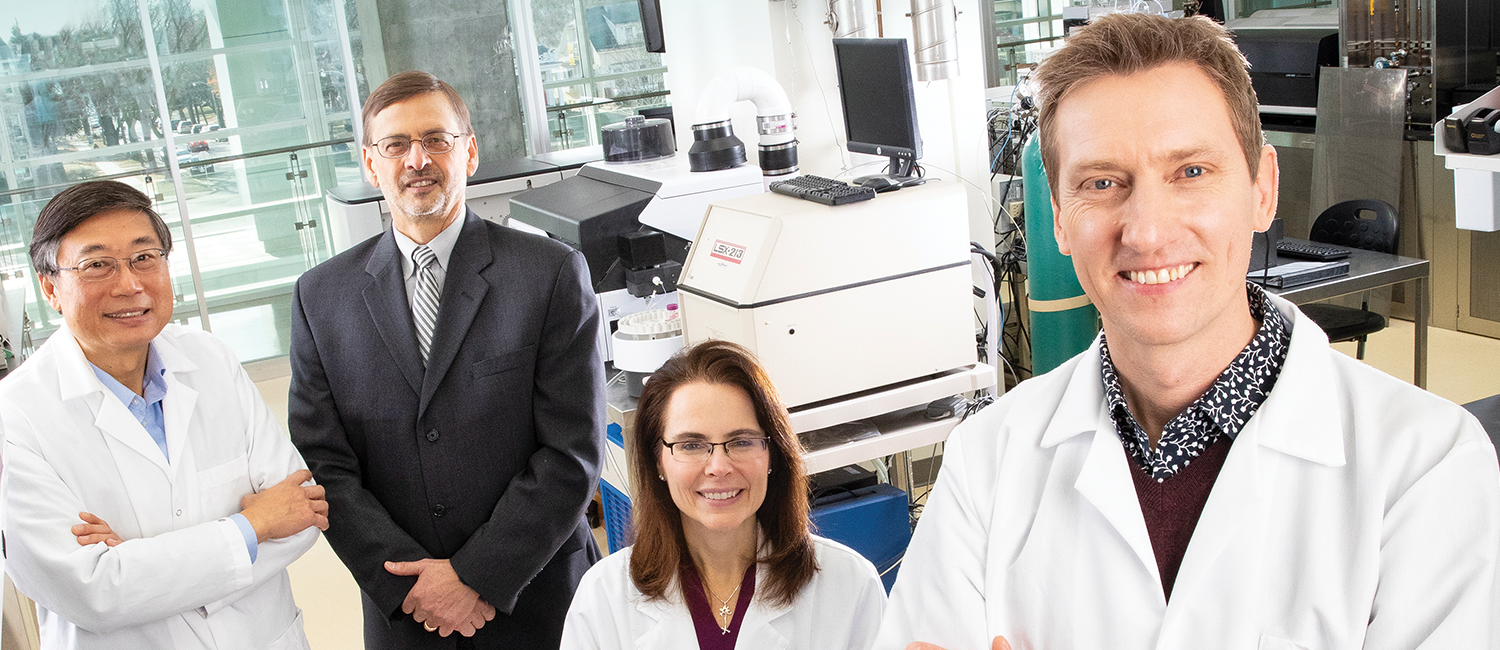
Nurturing new treatments
The Milwaukee Institute for Drug Discovery assists scientists in their quest to bring life-changing pharmaceuticals to the marketplace
It was supposed to be a drug that treated cardiovascular disease by widening blood vessels and increasing blood flow around the heart. But in early human trials, sildenafil showed promise for an entirely different purpose, and its creators realized the opportunity this presented.
So yes, one version of the drug was branded under its original intent – a medication to address hypertension. But you probably know sildenafil for its far more popular application: the blockbuster treatment for erectile dysfunction that goes by the brand name Viagra.
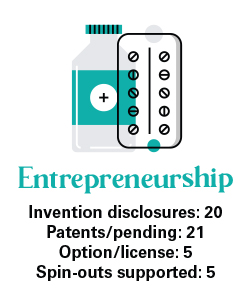
Although few drugs may be as successful as sildenafil, many have traveled down a similarly multifaceted path to the marketplace. It’s not uncommon for a drug that’s effective in one area to have a mode of action that also benefits another.
“Finding a new use for an old concept is part of the attraction of drug discovery,” says Alexander “Leggy” Arnold, an associate professor of chemistry and part of the research team at UWM’s Milwaukee Institute for Drug Discovery (MIDD).
Arnold and his MIDD colleagues approach their work with that versatility in mind. For example, Arnold has taken a compound originally designed to act in the brain to quell anxiety and is repurposing it to work in the lungs, where it treats asthma by taming inflammation through a similar molecular mechanism.
To continue this work, Arnold and his collaborators have launched a startup called Pantherics Inc. Their goal is to develop compounds based on a common mechanism for treating disorders involving inflammation of smooth muscle. Such an approach could go well beyond asthma treatments to helping people who suffer from irritable bowel syndrome and overactive bladder.
New drug innovation increasingly occurs in academic settings, such as MIDD faculty research labs, and typically is supported by federal grant funding. Yet the new drug development and approval process is lengthy and expensive, and often can require up to 15 years and a billion dollars to go from concept to patient use.
“Because of this,” explains MIDD Director Douglas Stafford, “entrepreneurial ventures bridge the gap between what can be done in the academic setting and the pharmaceutical companies, which fund expensive later stages of development, including large-scale manufacturing and FDA-mandated testing.”
So Stafford, a veteran biotech entrepreneur who is also president and CEO of Pantherics, focused on building an infrastructure that would give UWM faculty the tools to move drug compounds closer to commercialization and attract interest from investors. The MIDD was launched in 2011, with dual goals of advancing basic science and developing new pharmaceuticals. In 2014, MIDD opened the Shimadzu Laboratory for Advanced and Applied Analytical Chemistry, which provides researchers state-of-the-art tools necessary to advance drug development and other chemistry-oriented research.

You could say the MIDD model has evolved into a platform for new venture creation. Its scientific advances have occurred simultaneously with UWM’s emphasis on entrepreneurial training, which weaves innovative thinking into the educational fabric across disciplines, a catalyst for promising, new ideas. UWM also hosts the state’s only I-Corps site – funded by the National Science Foundation and led by the UWM Research Foundation – which helps academics learn how to turn lab discoveries into startup companies.
“There’s growing economic development potential from the commercialization of MIDD research,” Stafford says. “These are impressive projects that have great potential for improving health care.”
Indeed, the MIDD has spawned one drug-related startup company, Pantherics, and nurtured four others. Of 21 patents and patent applications arising from its faculty research, five have been optioned or licensed by the UWM Research Foundation.
The MIDD assists faculty entrepreneurs who want to transition their discoveries into startup ventures by providing access to essential drug validation expertise, regulatory knowledge and analytical instrumentation. The new $129.5 million chemistry building being designed for the UWM campus will expand these resources by providing key chemistry scale-up capabilities.
But much promising work is already well underway, and on the following pages, you’ll learn about three startups that have resulted from it. In addition to Pantherics, the MIDD has offered essential resources in developing Estrigenix Therapeutics and its research to prevent memory loss, as well as T3 BioScience, which takes a groundbreaking approach to protecting fruit trees from infection. These products could bring life-changing results to the marketplace, and their stories begin at UWM.
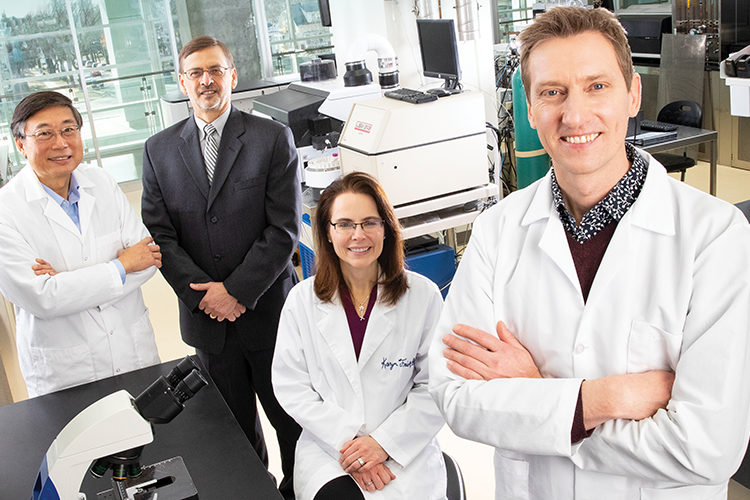
A new approach for treating asthma
Asthma doesn’t always respond to available medications, even with the drugs in widely used inhalers. In addition, children often don’t use these devices properly.
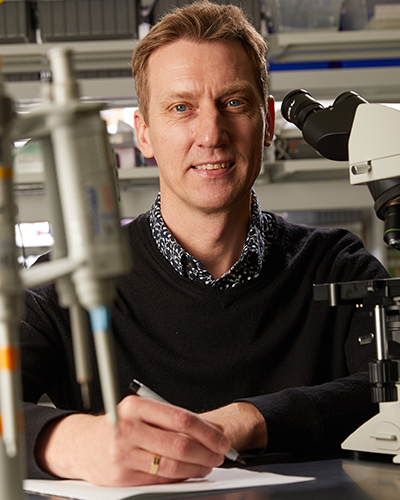
It’s a particular concern at and around UWM, because asthma afflicts Milwaukee residents at a rate much greater than the national average. Milwaukee County has the highest rate of emergency room visits for pediatric asthma in the state. Through the startup Pantherics, Arnold and other UWM scientists are helping develop an oral pill to treat this common but life-threatening disease.
For Arnold, transitioning the asthma drug research from lab studies toward developing a commercial product required some complementary focal points, such as regulatory compliance, manufacturing scale-up and developing investor interest.
“But unless you take the chance,” Arnold says, “you won’t get to see something you invented make it over all these hurdles to become a product that can help people.”
The new asthma drug tapped into a body of research done by James Cook. As a distinguished professor of chemistry, he worked for 40 years in new drug discovery at UWM. Much of Cook’s focus was on new drugs to treat central nervous system disorders without the adverse effects of existing medications, such as sedation or dependence.
During his career, Cook assembled a vast library of compounds, including benzodiazepines affecting the GABA receptors in the brain. They hold the promise of drug development for anxiety, depression, epilepsy and pain treatment, and all are grounded in innovative science.
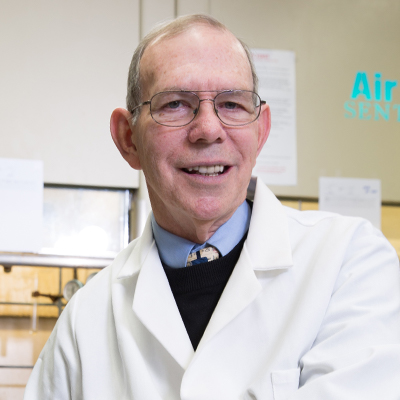
But asthma afflicts the lungs, not the brain. So Cook, Stafford, and Arnold teamed with Dr. Charles Emala, a Columbia University anesthesiologist, to investigate whether drug compounds could attach to GABA receptors in the lungs. Drugs that target GABA receptors in the brain can have a calming effect, and they found that the same pharmacological mechanism could tame the inflammation and airway constriction that are hallmarks of asthma.
Pantherics obtained rights to the asthma drug patents from the UWM Research Foundation with the goal of commercializing a product that Stafford says will compete in the global market for asthma drugs estimated to reach more than $28 billion by 2022.
They are well on their way. In the past year, Pantherics merged with a West Coast startup. Now, Pantherics has a research lab on the UWM campus and employs former UWM students to conduct preclinical studies on its drug candidates. They are optimizing the asthma compound prior to initial human clinical trials, which could happen in another year.
Tailoring estrogen to protect memory
Memory loss and Alzheimer’s disease strike women three times more often than men as they age, a result linked to a steep decline in estrogen hormones during menopause. But estrogen replacement comes with harmful side effects, such as an increased risk of heart disease and breast cancer.
Neuroscientist Karyn Frick has a pharmacological answer: Instead of avoiding estrogens, try removing the components responsible for the adverse effects.
Frick’s work has linked estrogens to the specific chemical processes known to create memories in both women and men. She and her collaborators have created an estrogen-like molecule shown to protect memory in a mouse model of post-menopausal dementia. That’s led to their startup company, Estrigenix Therapeutics Inc., which is developing drugs that affect the hormone and its complicated processes.
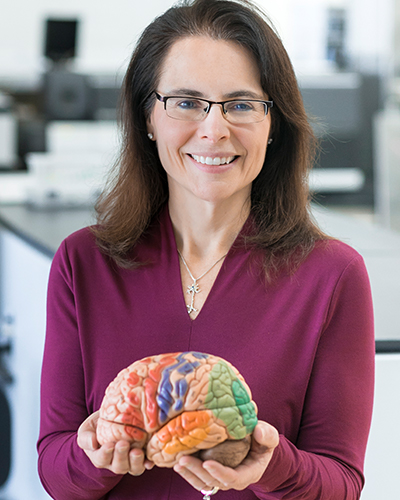
Estrogens act by binding to two dominant receptors, alpha and beta. Binding to the alpha receptor causes most of the adverse effects from estrogen replacement therapy in menopausal women. Estrigenix’s lead compound works by modifying the most potent form of estrogen so that it binds only to the beta receptor.
“There are multiple forms of estrogens in hormone replacement,” says Frick, a professor of psychology in the College of Letters & Science. “Some are beneficial for brain health, and some aren’t. Our molecule is a smaller version of the most potent form of estrogen, called estradiol, which is particularly diminished in menopause.”
Estrogens enhance male memory, too. Testosterone is converted to estrogens in men’s bodies for that purpose. Frick aims to pin down how the modified estrogen molecule acts in the brain to produce improved memory in both sexes.
Frick, who is a co-founder of Estrigenix with Concordia University Wisconsin’s Daniel Sem and Marquette University’s William Donaldson, says making the jump from longtime laboratory scientist to businessperson seemed daunting at first. But she soon learned to understand the language of business – and how to simplify the language that scientists use. She also realized that I-Corps entrepreneurial training had something in common with science.
“You use the information from interviews with potential customers to refine your business idea,” Frick says. “You take that data and make some decisions about whether there’s a viable path forward for the startup. It was interesting to see how that happened in a data-driven way.”
One lesson the team learned during the training process was that women and their doctors were more concerned with mood changes and hot flashes during menopause than the threat of memory loss at more advanced ages. That’s opened a new research path for the Estrigenix team, so Frick and her students are back in the lab to see if the compound can be effective at reducing these other troubling menopause symptoms.
The fruits of his labor
To protect apple and pear trees from fire blight – which can take out whole orchards – growers spray trees with streptomycin, an antibiotic that also is prescribed to fight infections in people. In fact, apples are among the crops most heavily sprayed with antibiotics, which contributes to antibiotic resistance in both the microbes on the tree’s flowers and the people who eat the fruit.
Ching-Hong Yang, a professor of biological sciences in the College of Letters & Science, discovered a nonantibiotic plant treatment that eliminates the threat of antibiotic resistance. He’s developed a chemical compound that enables “good” bacteria to obstruct the disease-causing microbes. He named his lead compound Rejulife A in honor of his father, who died of an antibiotic-resistant infection.
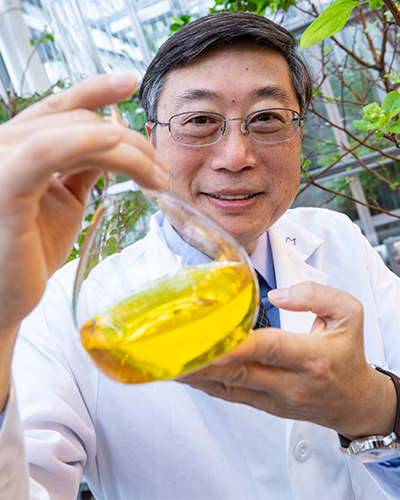
“Our whole objective is to discover antibiotic alternatives in agriculture,” says Yang. “We are building not only a new drug, but an entire platform.”
After four years of field testing, one of his natural compounds has proven more effective at controlling fire blight than streptomycin, and it poses no danger of promoting resistance to antibiotics.
To bring his work to the marketplace, Yang launched the startup T3 BioScience in 2012 and joined forces with serial entrepreneur Daniel Burgin in 2016. Since then, he’s created different compounds derived from bacteria that naturally exist on apple trees’ flowers, and all of them perform better than products currently available.
Yang’s compounds promote the growth of innocuous microbes so they can outcompete the harmful ones for space and nutrients by spreading more quickly and aggressively.
Yang and research collaborator Quan Zeng, a former student, took a reverse-engineering approach to developing their solution. They surveyed the flowers’ vast microbial landscape and identified the best performers among the potentially therapeutic bacteria.
Yang and Burgin have filed two patent applications and garnered the interest of several large agribusiness companies. One of those is interested in not only the antibiotic alternatives, but also Yang’s method of getting apple trees to blossom at any time of the year, an idea that’s appealing to other companies.
Because their products take a natural approach to treating plant disease, they hope for a relatively speedy approval from the Environmental Protection Agency. They also have future plans to branch into developing drugs for humans.